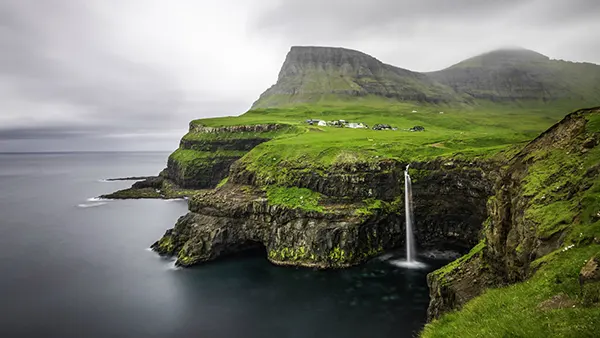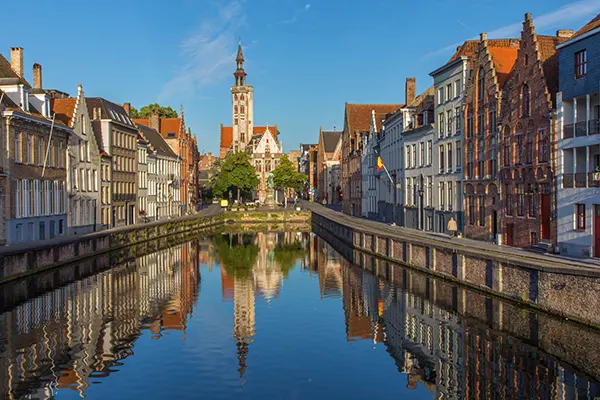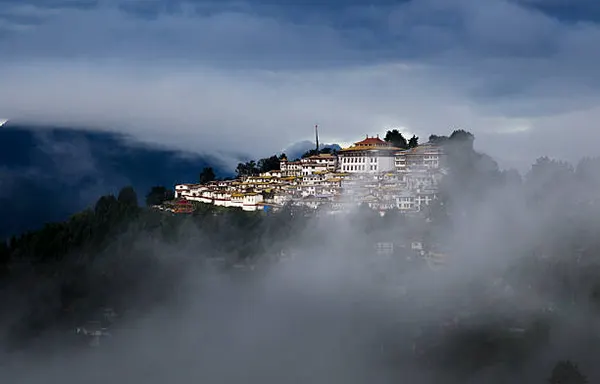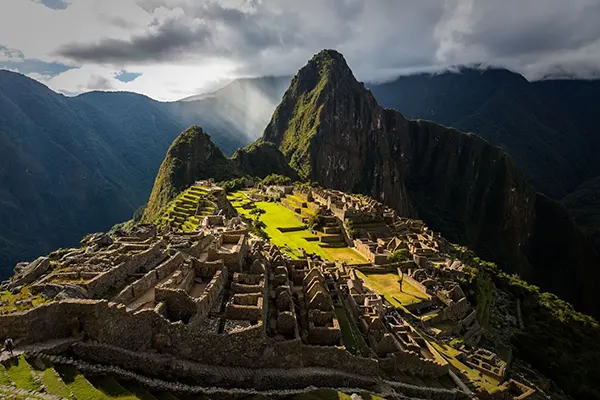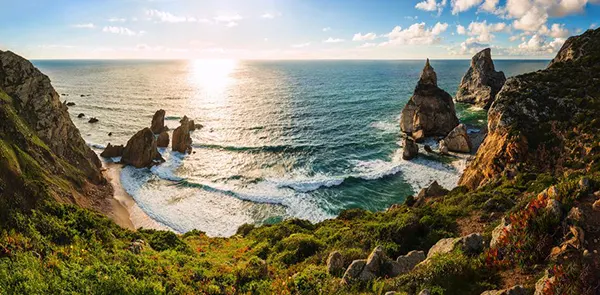
The Meeting Point of Oceans: Cape Roca – The Edge of Europe
Located in the scenic coastal landscape of Portugal, Cape Roca holds a special place in both geography and history. Often referred to as the westernmost point of continental Europe, this dramatic headland is a must-see for those exploring the Iberian Peninsula. The region surrounding Cape Roca is not only rich in natural beauty but also steeped in maritime history, making it a destination that attracts adventurers and historians alike.
Geography and Natural Beauty of Cape Roca
Perched on the rugged cliffs of Portugal, Cape Roca offers stunning panoramic views over the Atlantic Ocean. The towering cliffs, some reaching up to 140 meters in height, present a striking landscape where the land seems to plunge directly into the ocean below. This location, where the land ends and the sea begins, creates an almost mystical atmosphere, making it one of Portugal’s most iconic natural landmarks.
As part of the Sintra-Cascais Natural Park, Cape Roca is surrounded by lush greenery, unique flora, and fauna that add to its allure. The area is well known for its diverse plant species, which thrive in the temperate Mediterranean climate. The scenic beauty and tranquil environment make it a perfect spot for those seeking to connect with nature or enjoy a peaceful walk along the coastline.
The powerful winds and unpredictable waves that crash against the cliffs further highlight the raw force of nature at Cape Roca. The isolation of this location adds to its charm, offering a peaceful escape from the bustling cities of Lisbon and Cascais, which are just a short drive away. The combination of its dramatic geography and natural beauty ensures that Cape Roca remains an unforgettable destination for travelers.
The Historical Significance of Cape Roca
Beyond its breathtaking natural features, Cape Roca is also deeply intertwined with Portugal’s rich maritime history. In the 15th century, it marked a crucial point in the Age of Exploration. Portuguese navigators, most notably Vasco da Gama, sailed past this landmark as they ventured into the unknown waters of the Atlantic Ocean, paving the way for further exploration and trade.
The iconic lighthouse at Cape Roca, built in 1772, stands as a testament to Portugal’s historical maritime dominance. The lighthouse continues to serve as a beacon for sailors, guiding them safely along the dangerous coastline. Its red-and-white striped tower has become one of the most photographed landmarks in Portugal, symbolising both the region’s history and its ongoing role in maritime safety.
In addition to its connection to exploration, Cape Roca has long been a symbol of the boundary between the known and the unknown. The inscription on the commemorative stone at the cape reads, “Here, where the land ends and the sea begins,” emphasizing its role as a gateway to the vast Atlantic Ocean. This phrase has resonated through centuries, representing both the limits of European geography and the spirit of discovery that defined Portugal’s seafaring legacy.
Tourism and Accessibility of Cape Roca
Today, Cape Roca is a popular tourist destination, drawing visitors from around the world. Its accessibility from Lisbon, just 40 minutes away by car, makes it an ideal day trip for those looking to experience both the historical and natural beauty of the region. The surrounding area is well-equipped with tourist services, including a visitor centre that offers educational resources about the cape’s history and geography.
Many visitors to Cape Roca enjoy walking along the well-maintained paths that wind through the natural park, offering spectacular views of the cliffs and ocean. The rugged coastline provides an excellent spot for photography, with the waves crashing against the rocks creating dramatic scenery. The area is also a popular destination for hiking and birdwatching, with numerous species of seabirds calling the cliffs home.
The cape’s popularity as a tourist destination is further enhanced by its proximity to other key attractions in the Lisbon region. Nearby Sintra, a UNESCO World Heritage site, offers visitors the chance to explore opulent palaces and lush gardens, while the coastal town of Cascais provides a lively atmosphere and picturesque beaches. The combination of natural beauty, rich history, and accessible location makes Cape Roca an essential stop for any traveller visiting Portugal.
Visitor Tips and Best Time to Visit Cape Roca
For those planning a visit to Cape Roca, it’s important to consider the best time to go. While the cape is accessible year-round, the summer months tend to be the busiest, with large numbers of tourists flocking to the region. For a more tranquil experience, the spring and autumn months are ideal, offering mild temperatures and fewer crowds.
It is also advisable to check the weather before visiting, as the coastal winds can be quite strong, especially in the winter months. Proper footwear is recommended for those who wish to explore the hiking trails, as the terrain can be rocky and uneven. Visitors should also be mindful of the environment and respect the natural surroundings, ensuring that Cape Roca remains a pristine and unspoiled destination for generations to come.
While at the cape, visitors can enjoy the many viewpoints that offer spectacular views of the coastline and the vast ocean beyond. The stone monument, which marks the westernmost point of Europe, is a popular photo spot. Additionally, the nearby café provides a perfect place to relax and enjoy a coffee while taking in the scenery. Whether you’re a history enthusiast or a nature lover, Cape Roca offers something for everyone.
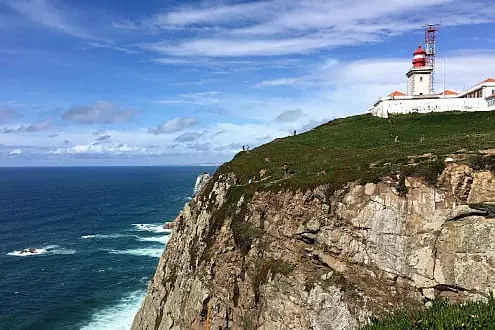
The Legacy of Cape Roca in European Culture
Cape Roca is not only a geographical landmark but also a cultural symbol for Portugal and Europe. Over the centuries, it has inspired countless artists, poets, and writers. The cape’s dramatic landscape has been immortalised in literature and art, often representing the spirit of adventure and exploration that characterized the Age of Discovery.
In addition to its artistic influence, Cape Roca has been the subject of numerous poems and literary works, most notably by the poet Luís de Camões, whose famous epic “The Lusiads” recounts the journey of Vasco da Gama. The cape’s role in this literary masterpiece highlights its importance as a symbol of courage and exploration. For those interested in the literary history of the region, Cape Roca offers a connection to these iconic works of European literature.
As one of Europe’s most iconic natural and historical landmarks, Cape Roca continues to serve as a reminder of Europe’s maritime past. Its role in the exploration of the world during the Age of Discovery remains a point of pride for Portugal, symbolising the courage and determination of those who sailed beyond the known world in search of new horizons.
Importance of Cape Roca in Modern-Day Portugal
Today, Cape Roca stands not only as a historical and cultural symbol but also as a beloved national treasure. It draws millions of visitors annually, many of whom travel from all over the world to experience its unique blend of natural beauty and historical significance. The lighthouse, still functioning today, continues to serve as a beacon to sailors navigating the Atlantic Ocean.
The site also plays a significant role in modern tourism, contributing to the local economy by attracting visitors to the region. Tourists come not only to marvel at the breathtaking views but also to appreciate the connection between Cape Roca and Portugal’s age of exploration. The cape remains a place where the spirit of adventure continues to inspire those who visit.
Furthermore, the area surrounding Cape Roca has been carefully preserved to maintain its natural beauty. Efforts to protect the environment ensure that future generations will be able to enjoy this remarkable landmark just as previous generations have. Cape Roca’s enduring presence in Portugal’s cultural landscape highlights its importance both in history and in contemporary life.


